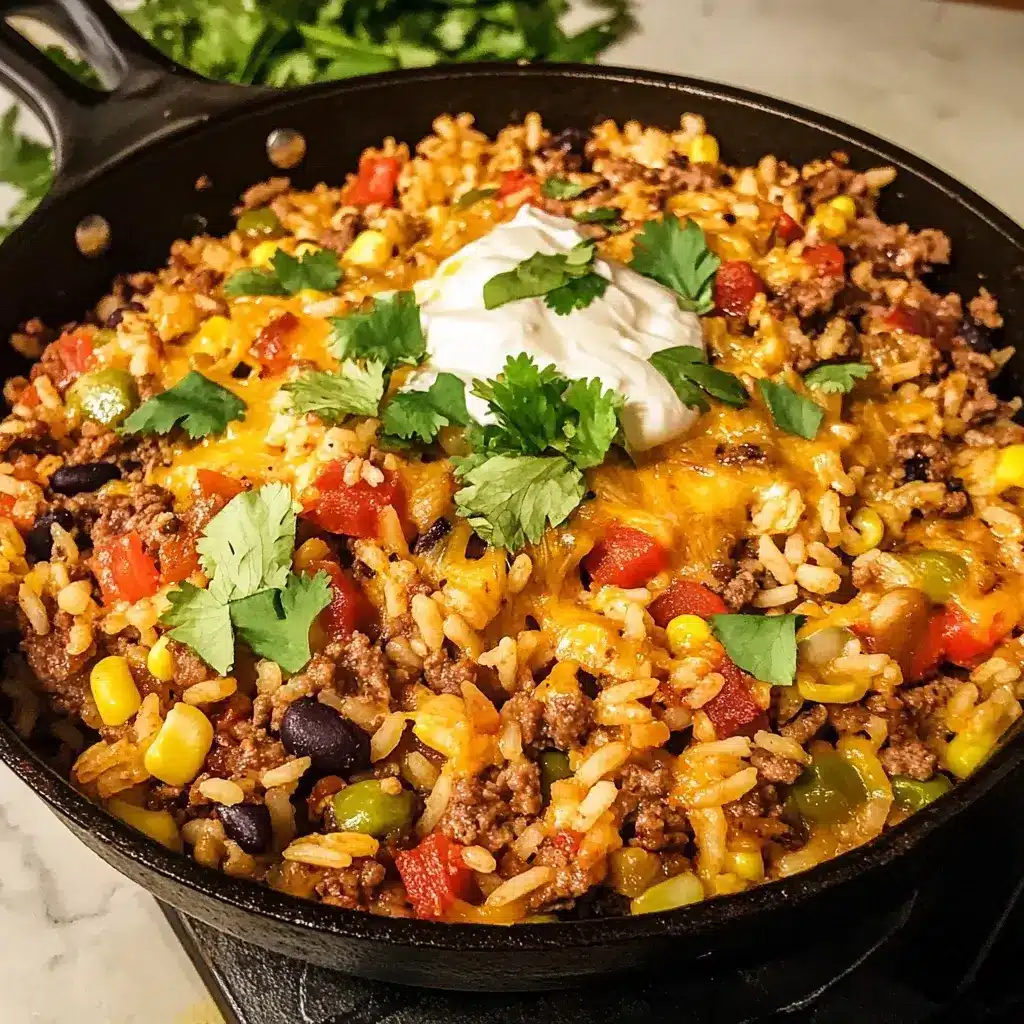It’s funny how some of the best recipes are born from a desire for simplicity and hearty flavors. Cowboy Beef and Rice Skillet? Honestly, the name itself just conjures up images of crackling campfires and satisfying, no-fuss meals. When I first stumbled upon this recipe, I was intrigued by its promise of a one-pan wonder that could please even the pickiest eaters in my family. Let me tell you, it absolutely delivered! From the moment the aroma of browning beef and sautéed vegetables filled my kitchen, I knew this was going to be a hit. And it was. My kids, who can sometimes be culinary critics in disguise, devoured it. My husband, a man of few words when it comes to food, actually asked for seconds – a rare and cherished compliment in our household. The beauty of this Cowboy Beef and Rice Skillet lies in its incredible ease and the depth of flavor it packs. It’s the kind of meal that feels both comforting and exciting, perfect for a busy weeknight or a relaxed weekend dinner. Trust me, once you try this, it will become a regular in your recipe rotation – it certainly has in mine!
Ingredients for a Flavorful Cowboy Beef and Rice Skillet
To embark on your Cowboy Beef and Rice Skillet adventure, you’ll need a collection of readily available ingredients that, when combined, create a symphony of savory, satisfying flavors. Each ingredient plays a crucial role in building the overall taste and texture of this delightful one-pan meal. Let’s break down each component and understand why it’s essential for achieving the perfect Cowboy Beef and Rice Skillet.
- Ground Beef: The heart and soul of this dish, ground beef provides the meaty foundation and robust flavor that defines “cowboy” cuisine. We recommend using lean ground beef (80/20 or 85/15) to minimize excess grease while still retaining enough fat for flavor. You can also experiment with ground sirloin or even ground bison for a slightly different taste profile. The key is to use high-quality ground beef as it significantly impacts the overall richness of the dish. For a vegetarian or vegan option, consider using plant-based ground beef alternatives, ensuring they are suitable for skillet cooking and retain texture during simmering.
- Long Grain White Rice: The fluffy, absorbent base for our savory beef and vegetable mixture. Long grain white rice is ideal because it cooks evenly and holds its shape well, preventing a mushy texture. While white rice is traditional, you can also explore using brown rice for a nuttier flavor and added fiber. If opting for brown rice, remember to adjust the cooking time and liquid quantity as it requires longer to cook and absorbs more liquid than white rice. For a quicker cooking option, consider using parboiled rice, which cooks faster than regular long grain rice.
- Diced Tomatoes: These juicy, tangy tomatoes provide essential moisture and acidity to the skillet, balancing the richness of the beef and adding a vibrant, fresh element. Canned diced tomatoes are perfectly convenient and flavorful for this recipe. You can choose between regular diced tomatoes or fire-roasted diced tomatoes for a smoky depth. For an extra layer of flavor, consider using diced tomatoes with green chilies for a subtle kick. Ensure you drain excess liquid from the diced tomatoes before adding them to the skillet to prevent the dish from becoming too watery.
- Bell Peppers (Various Colors): Bell peppers bring a delightful sweetness and crisp-tender texture to the skillet, along with a boost of vitamins and vibrant color. Using a mix of bell peppers (red, green, yellow, orange) not only enhances the visual appeal but also adds a complexity of flavors. Green bell peppers offer a slightly bitter note, while red and yellow bell peppers are sweeter. Orange bell peppers are a milder, sweeter option. Feel free to use your favorite combination or whatever bell peppers you have readily available. For a spicier kick, you could incorporate a small amount of chopped jalapeño or poblano pepper along with the bell peppers.
- Onion: The aromatic foundation of countless savory dishes, onion contributes a pungent yet sweet flavor that deepens as it cooks, adding complexity to the skillet. Yellow or white onions are excellent choices for this recipe due to their versatile flavor profile. Dice the onion into uniform pieces to ensure even cooking and consistent flavor throughout the dish. For a milder onion flavor, you can use shallots or sweet onions as substitutes.
- Garlic: No savory dish is truly complete without the pungent, aromatic magic of garlic. Fresh garlic cloves, minced or pressed, are essential for infusing the Cowboy Beef and Rice Skillet with its signature savory depth. Use fresh garlic whenever possible for the best flavor. If you’re in a pinch, you can use pre-minced garlic, but fresh garlic offers a brighter and more intense flavor. Don’t be shy with the garlic; it complements the beef and vegetables beautifully.
- Beef Broth (or Chicken Broth): The cooking liquid that not only cooks the rice to perfection but also adds another layer of savory beef flavor. Beef broth is the ideal choice to enhance the beefy character of the dish, but chicken broth works equally well and provides a lighter flavor profile. Low-sodium broth is recommended to control the saltiness of the final dish. You can also use vegetable broth for a vegetarian version or even water in a pinch, though broth will significantly enhance the flavor.
- Chili Powder: The signature spice that gives this skillet its “cowboy” kick and warm, Southwestern-inspired flavor. Chili powder is a blend of spices, typically including dried chilies, cumin, oregano, and garlic powder. It adds a complex, slightly smoky, and moderately spicy flavor. Adjust the amount of chili powder to your spice preference – start with the recommended amount and add more to taste if you prefer a spicier dish. For a milder flavor, use a mild chili powder blend or reduce the quantity.
- Cumin: Earthy and warm, cumin enhances the chili powder and adds a distinctive Southwestern aroma to the skillet. Ground cumin is readily available and easy to use. Its warm, slightly bitter notes complement the beef and other spices beautifully. If you have whole cumin seeds, you can lightly toast them in a dry skillet before grinding them for an even more intense flavor.
- Dried Oregano: A classic herb in Southwestern and Mexican cuisine, dried oregano provides a slightly peppery and earthy flavor that complements the beef and spices. Dried oregano is readily available and adds a subtle herbaceousness to the dish. If you have fresh oregano, you can use it as a garnish at the end, but dried oregano is preferred for cooking as it releases its flavor more readily during simmering.
- Salt and Black Pepper: Essential seasonings to enhance all the flavors and bring balance to the dish. Use salt to taste, starting with a reasonable amount and adjusting as needed. Freshly ground black pepper is always preferred for its brighter flavor. Seasoning throughout the cooking process, rather than just at the end, helps to develop layers of flavor.
- Optional: Shredded Cheddar Cheese: For a creamy, cheesy finish that melts beautifully over the hot skillet, shredded cheddar cheese is a fantastic optional addition. Cheddar cheese adds a sharp, savory flavor and a delightful melty texture. You can use mild, medium, or sharp cheddar cheese depending on your preference. Other cheese options include Monterey Jack, Colby Jack, or a blend of Mexican cheeses. If you’re looking for a dairy-free option, consider using a plant-based shredded cheese alternative that melts well.
Step-by-Step Instructions for Cooking Cowboy Beef and Rice Skillet
Creating this Cowboy Beef and Rice Skillet is surprisingly straightforward, even for novice cooks. Following these detailed instructions will guide you through each step, ensuring a delicious and satisfying meal every time. Let’s break down the cooking process into clear, manageable steps.
- Brown the Ground Beef: Heat a large skillet (preferably cast iron or another oven-safe skillet) over medium-high heat. Add the ground beef to the hot skillet. Break it up with a spoon or spatula and cook, stirring occasionally, until it is browned and no longer pink. This process typically takes about 5-7 minutes. Browning the beef is crucial for developing rich, savory flavors and preventing a bland taste.
- Drain Excess Fat: Once the ground beef is browned, carefully drain off any excess fat from the skillet. This step is important to prevent the dish from becoming greasy and to ensure a healthier final product. Tilting the skillet and using a spoon to scoop out the fat is an effective method. Alternatively, you can carefully transfer the browned beef to a colander to drain, then return it to the skillet.
- Sauté Aromatics and Vegetables: Return the skillet to medium heat. Add the diced onion and bell peppers to the skillet with the browned beef. Cook, stirring occasionally, until the onions become softened and translucent and the bell peppers are slightly tender-crisp, about 5-7 minutes. Sautéing the onions and bell peppers at this stage releases their flavors and creates a flavorful base for the rest of the dish. Don’t rush this step; allowing the vegetables to soften slightly enhances their sweetness.
- Add Garlic and Spices: Add the minced garlic, chili powder, cumin, and dried oregano to the skillet. Cook, stirring constantly, for about 1 minute, or until the spices become fragrant. This step, often referred to as “blooming” the spices, is essential for releasing their full flavor potential. Cooking the spices briefly in the heat enhances their aroma and infuses the dish with their complex flavors. Be careful not to burn the garlic or spices; cook just until fragrant.
- Incorporate Tomatoes and Broth: Pour in the diced tomatoes (undrained) and beef broth (or chicken broth) into the skillet. Stir well to combine all the ingredients and scrape up any browned bits from the bottom of the skillet – these browned bits add a lot of flavor! Ensure that the liquid covers the beef and vegetables evenly.
- Add Rice and Simmer: Stir in the long grain white rice into the skillet. Bring the mixture to a boil, then reduce the heat to low, cover the skillet tightly with a lid, and simmer for 18-20 minutes, or until the rice is cooked through and has absorbed most of the liquid. It’s crucial to keep the skillet covered during simmering to allow the rice to steam and cook properly. Avoid lifting the lid too often, as this can release steam and prolong the cooking time. If using brown rice, simmering time will be longer, approximately 40-50 minutes.
- Check for Doneness and Adjust Liquid (If Needed): After simmering for the recommended time, check if the rice is tender and most of the liquid has been absorbed. If the rice is still too firm or there is too much liquid remaining, continue to simmer, covered, for a few more minutes, checking periodically. If the skillet seems too dry before the rice is cooked, add a little more broth, about ¼ cup at a time, to prevent sticking and ensure the rice cooks through.
- Rest and Fluff: Once the rice is cooked, remove the skillet from the heat and let it stand, covered, for 5-10 minutes. This resting period allows the rice to fully absorb any remaining liquid and become perfectly fluffy. After resting, fluff the rice gently with a fork to separate the grains and incorporate any remaining moisture.
- Add Cheese (Optional): If using cheddar cheese, sprinkle the shredded cheese evenly over the top of the skillet. Cover the skillet again (or place it under a broiler for a minute or two, watching carefully to prevent burning) and let the cheese melt and become gooey and delicious.
- Serve and Enjoy: Your Cowboy Beef and Rice Skillet is now ready to be served! Garnish with fresh cilantro, chopped green onions, or a dollop of sour cream (optional). Serve hot and enjoy this hearty, flavorful one-pan meal.
Nutrition Facts for Cowboy Beef and Rice Skillet
Understanding the nutritional content of your meals is important for making informed dietary choices. While the exact nutritional values can vary based on specific ingredients and portion sizes, here’s an estimated breakdown of the nutrition facts for a single serving of Cowboy Beef and Rice Skillet.
Servings: This recipe typically yields approximately 6 servings.
Estimated Calories per Serving: Approximately 450-550 calories per serving.
Approximate Nutritional Breakdown (per serving):
- Protein: 30-35 grams
- Fat: 20-25 grams (depending on the leaness of ground beef and cheese)
- Saturated Fat: 8-10 grams (depending on the leaness of ground beef and cheese)
- Cholesterol: 80-100 mg
- Sodium: 500-700 mg (depending on broth and added salt)
- Carbohydrates: 40-50 grams
- Fiber: 3-5 grams
- Sugar: 5-7 grams
Important Notes:
- These values are estimates and can vary based on the specific brands and types of ingredients used, as well as portion sizes.
- Using leaner ground beef and reducing or omitting cheese can significantly reduce the fat and calorie content.
- Adding more vegetables will increase the fiber content and nutrient density.
- For more precise nutritional information, you can use online recipe analyzers or nutrition tracking apps, inputting the specific ingredients and quantities you use.
Preparation Time for Cowboy Beef and Rice Skillet
One of the many appeals of Cowboy Beef and Rice Skillet is its relatively quick preparation time, making it ideal for weeknight dinners or when you need a satisfying meal without spending hours in the kitchen.
Prep Time: Approximately 15-20 minutes (this includes chopping vegetables, mincing garlic, and gathering ingredients).
Cook Time: Approximately 30 minutes (this includes browning beef, sautéing vegetables, simmering rice).
Total Time: Approximately 45-50 minutes from start to finish.
This timeframe makes Cowboy Beef and Rice Skillet a convenient and efficient meal option. The active cooking time is relatively short, and much of the cooking process is hands-off simmering, allowing you to attend to other tasks while dinner is cooking.
How to Serve Cowboy Beef and Rice Skillet
Cowboy Beef and Rice Skillet is a versatile dish that can be enjoyed in various ways. Its hearty and flavorful nature makes it a satisfying meal on its own, but it also pairs wonderfully with a variety of accompaniments to create a complete and balanced dining experience. Here are some serving suggestions:
- Classic Toppings:
- Shredded Cheddar Cheese: (If not already added during cooking) A classic and always welcome topping that adds extra cheesy goodness.
- Sour Cream or Greek Yogurt: A dollop of cool sour cream or Greek yogurt provides a creamy contrast to the savory skillet and adds a touch of tanginess.
- Salsa or Pico de Gallo: Fresh salsa or pico de gallo brings a vibrant, zesty flavor and a refreshing element to the dish.
- Chopped Green Onions or Cilantro: Fresh herbs add a pop of color and a bright, herbaceous finish.
- Avocado or Guacamole: Creamy avocado slices or guacamole adds richness and healthy fats.
- Side Dishes for a Complete Meal:
- Cornbread or Biscuits: Serve with warm cornbread or flaky biscuits for a classic Southern-inspired pairing.
- Side Salad: A simple green salad with a light vinaigrette provides a refreshing contrast to the richness of the skillet.
- Coleslaw: Creamy or vinegar-based coleslaw adds a crunchy texture and cool, tangy flavor.
- Steamed or Roasted Vegetables: Serve alongside steamed broccoli, green beans, or roasted asparagus for added nutrients and balance.
- Black Beans or Refried Beans: For an even heartier meal, serve with a side of black beans or refried beans.
- Serving Styles:
- Bowl Meals: Serve generous portions of the Cowboy Beef and Rice Skillet in bowls as a comforting and satisfying main course.
- Burrito Bowls: Transform it into a burrito bowl by serving over a bed of shredded lettuce with toppings like salsa, sour cream, and avocado.
- Baked Potato Topping: Spoon the Cowboy Beef and Rice Skillet over baked potatoes for a loaded baked potato meal.
- Stuffed Bell Peppers: Use the skillet mixture to stuff bell peppers for a creative and flavorful twist.
Additional Tips for the Best Cowboy Beef and Rice Skillet
To elevate your Cowboy Beef and Rice Skillet from good to truly outstanding, consider these helpful tips and tricks gleaned from experienced home cooks:
- Don’t Skimp on Browning the Beef: Taking the time to properly brown the ground beef at the beginning is crucial for developing deep, savory flavors. Don’t just cook it until it’s no longer pink; let it get nicely browned, even slightly crispy in some spots. This browning process, known as the Maillard reaction, creates hundreds of flavor compounds that enhance the overall taste of the dish.
- Bloom Your Spices: Cooking the chili powder, cumin, and oregano in the skillet with the vegetables for a minute or two before adding the liquid is essential for releasing their full flavor potential. The heat helps to “bloom” the spices, intensifying their aroma and flavor and ensuring they infuse the entire dish beautifully. Be careful not to burn the spices; cook just until fragrant.
- Use Quality Broth: The broth is the cooking liquid for the rice and significantly contributes to the overall flavor of the skillet. Using a good quality beef broth (or chicken broth) will make a noticeable difference. Low-sodium broth is recommended so you can control the saltiness of the final dish. If you have homemade broth, even better!
- Adjust Spice Level to Your Preference: The recipe is written for a moderate spice level using chili powder. If you prefer a milder dish, start with less chili powder and taste as you go. If you like it spicier, increase the chili powder, add a pinch of cayenne pepper, or incorporate some diced jalapeños or a dash of hot sauce. Remember, you can always add more spice, but it’s harder to take it away, so start conservatively and adjust to your liking.
- Make it Ahead and Reheat Beautifully: Cowboy Beef and Rice Skillet is a fantastic make-ahead meal. It actually tastes even better the next day as the flavors have had time to meld and deepen. You can prepare the entire skillet ahead of time, let it cool completely, and store it in an airtight container in the refrigerator for up to 3-4 days. To reheat, simply warm it up in a skillet over medium heat, adding a splash of broth or water if needed to keep it moist. You can also reheat it in the microwave.
Frequently Asked Questions (FAQ) about Cowboy Beef and Rice Skillet
Here are some common questions and answers to help you successfully prepare and enjoy Cowboy Beef and Rice Skillet:
Q1: Can I use a different type of rice besides long grain white rice?
A1: Yes, you can substitute other types of rice, but you’ll need to adjust the cooking time and liquid accordingly. Brown rice is a good alternative for a nuttier flavor and added fiber, but it will require longer cooking time (around 40-50 minutes) and may need slightly more liquid. Parboiled rice cooks faster than regular long grain rice. Avoid using short grain rice like sushi rice, as it can become too sticky and mushy in this dish.
Q2: Can I make this recipe vegetarian or vegan?
A2: Absolutely! To make it vegetarian, simply substitute the ground beef with a plant-based ground beef alternative. Ensure it’s suitable for skillet cooking and retains texture during simmering. For a vegan version, also ensure that your plant-based beef alternative is vegan, and omit the cheddar cheese topping or use a vegan shredded cheese alternative. You can also enhance the vegetable content by adding more bell peppers, zucchini, or corn to make it even heartier.
Q3: How do I store leftovers of Cowboy Beef and Rice Skillet?
A3: Store leftover Cowboy Beef and Rice Skillet in an airtight container in the refrigerator for up to 3-4 days. Ensure the skillet has cooled completely before refrigerating. Reheat thoroughly before serving.
Q4: Can I freeze Cowboy Beef and Rice Skillet?
A4: Yes, this skillet freezes well. Allow it to cool completely, then transfer it to freezer-safe containers or freezer bags. Freeze for up to 2-3 months. Thaw overnight in the refrigerator before reheating. Reheating may slightly alter the texture of the rice, but the flavor will remain delicious.
Q5: What if my rice is still not cooked after the recommended simmering time?
A5: If your rice is still firm after 20 minutes of simmering, it likely needs more liquid and cooking time. Add ¼ cup of broth or water to the skillet, cover it tightly, and continue to simmer for another 5-10 minutes, checking periodically until the rice is tender and most of the liquid is absorbed. Altitude, skillet type, and rice variety can slightly affect cooking times, so it’s always best to check for doneness rather than strictly adhering to the time.
Print
Cowboy Beef and Rice Skillet recipe
Ingredients
-
- Ground Beef: The heart and soul of this dish, ground beef provides the meaty foundation and robust flavor that defines “cowboy” cuisine. We recommend using lean ground beef (80/20 or 85/15) to minimize excess grease while still retaining enough fat for flavor. You can also experiment with ground sirloin or even ground bison for a slightly different taste profile. The key is to use high-quality ground beef as it significantly impacts the overall richness of the dish. For a vegetarian or vegan option, consider using plant-based ground beef alternatives, ensuring they are suitable for skillet cooking and retain texture during simmering.
-
- Long Grain White Rice: The fluffy, absorbent base for our savory beef and vegetable mixture. Long grain white rice is ideal because it cooks evenly and holds its shape well, preventing a mushy texture. While white rice is traditional, you can also explore using brown rice for a nuttier flavor and added fiber. If opting for brown rice, remember to adjust the cooking time and liquid quantity as it requires longer to cook and absorbs more liquid than white rice. For a quicker cooking option, consider using parboiled rice, which cooks faster than regular long grain rice.
-
- Diced Tomatoes: These juicy, tangy tomatoes provide essential moisture and acidity to the skillet, balancing the richness of the beef and adding a vibrant, fresh element. Canned diced tomatoes are perfectly convenient and flavorful for this recipe. You can choose between regular diced tomatoes or fire-roasted diced tomatoes for a smoky depth. For an extra layer of flavor, consider using diced tomatoes with green chilies for a subtle kick. Ensure you drain excess liquid from the diced tomatoes before adding them to the skillet to prevent the dish from becoming too watery.
-
- Bell Peppers (Various Colors): Bell peppers bring a delightful sweetness and crisp-tender texture to the skillet, along with a boost of vitamins and vibrant color. Using a mix of bell peppers (red, green, yellow, orange) not only enhances the visual appeal but also adds a complexity of flavors. Green bell peppers offer a slightly bitter note, while red and yellow bell peppers are sweeter. Orange bell peppers are a milder, sweeter option. Feel free to use your favorite combination or whatever bell peppers you have readily available. For a spicier kick, you could incorporate a small amount of chopped jalapeño or poblano pepper along with the bell peppers.
-
- Onion: The aromatic foundation of countless savory dishes, onion contributes a pungent yet sweet flavor that deepens as it cooks, adding complexity to the skillet. Yellow or white onions are excellent choices for this recipe due to their versatile flavor profile. Dice the onion into uniform pieces to ensure even cooking and consistent flavor throughout the dish. For a milder onion flavor, you can use shallots or sweet onions as substitutes.
-
- Garlic: No savory dish is truly complete without the pungent, aromatic magic of garlic. Fresh garlic cloves, minced or pressed, are essential for infusing the Cowboy Beef and Rice Skillet with its signature savory depth. Use fresh garlic whenever possible for the best flavor. If you’re in a pinch, you can use pre-minced garlic, but fresh garlic offers a brighter and more intense flavor. Don’t be shy with the garlic; it complements the beef and vegetables beautifully.
-
- Beef Broth (or Chicken Broth): The cooking liquid that not only cooks the rice to perfection but also adds another layer of savory beef flavor. Beef broth is the ideal choice to enhance the beefy character of the dish, but chicken broth works equally well and provides a lighter flavor profile. Low-sodium broth is recommended to control the saltiness of the final dish. You can also use vegetable broth for a vegetarian version or even water in a pinch, though broth will significantly enhance the flavor.
-
- Chili Powder: The signature spice that gives this skillet its “cowboy” kick and warm, Southwestern-inspired flavor. Chili powder is a blend of spices, typically including dried chilies, cumin, oregano, and garlic powder. It adds a complex, slightly smoky, and moderately spicy flavor. Adjust the amount of chili powder to your spice preference – start with the recommended amount and add more to taste if you prefer a spicier dish. For a milder flavor, use a mild chili powder blend or reduce the quantity.
-
- Cumin: Earthy and warm, cumin enhances the chili powder and adds a distinctive Southwestern aroma to the skillet. Ground cumin is readily available and easy to use. Its warm, slightly bitter notes complement the beef and other spices beautifully. If you have whole cumin seeds, you can lightly toast them in a dry skillet before grinding them for an even more intense flavor.
-
- Dried Oregano: A classic herb in Southwestern and Mexican cuisine, dried oregano provides a slightly peppery and earthy flavor that complements the beef and spices. Dried oregano is readily available and adds a subtle herbaceousness to the dish. If you have fresh oregano, you can use it as a garnish at the end, but dried oregano is preferred for cooking as it releases its flavor more readily during simmering.
-
- Salt and Black Pepper: Essential seasonings to enhance all the flavors and bring balance to the dish. Use salt to taste, starting with a reasonable amount and adjusting as needed. Freshly ground black pepper is always preferred for its brighter flavor. Seasoning throughout the cooking process, rather than just at the end, helps to develop layers of flavor.
-
- Optional: Shredded Cheddar Cheese: For a creamy, cheesy finish that melts beautifully over the hot skillet, shredded cheddar cheese is a fantastic optional addition. Cheddar cheese adds a sharp, savory flavor and a delightful melty texture. You can use mild, medium, or sharp cheddar cheese depending on your preference. Other cheese options include Monterey Jack, Colby Jack, or a blend of Mexican cheeses. If you’re looking for a dairy-free option, consider using a plant-based shredded cheese alternative that melts well.
Instructions
-
- Brown the Ground Beef: Heat a large skillet (preferably cast iron or another oven-safe skillet) over medium-high heat. Add the ground beef to the hot skillet. Break it up with a spoon or spatula and cook, stirring occasionally, until it is browned and no longer pink. This process typically takes about 5-7 minutes. Browning the beef is crucial for developing rich, savory flavors and preventing a bland taste.
-
- Drain Excess Fat: Once the ground beef is browned, carefully drain off any excess fat from the skillet. This step is important to prevent the dish from becoming greasy and to ensure a healthier final product. Tilting the skillet and using a spoon to scoop out the fat is an effective method. Alternatively, you can carefully transfer the browned beef to a colander to drain, then return it to the skillet.
-
- Sauté Aromatics and Vegetables: Return the skillet to medium heat. Add the diced onion and bell peppers to the skillet with the browned beef. Cook, stirring occasionally, until the onions become softened and translucent and the bell peppers are slightly tender-crisp, about 5-7 minutes. Sautéing the onions and bell peppers at this stage releases their flavors and creates a flavorful base for the rest of the dish. Don’t rush this step; allowing the vegetables to soften slightly enhances their sweetness.
-
- Add Garlic and Spices: Add the minced garlic, chili powder, cumin, and dried oregano to the skillet. Cook, stirring constantly, for about 1 minute, or until the spices become fragrant. This step, often referred to as “blooming” the spices, is essential for releasing their full flavor potential. Cooking the spices briefly in the heat enhances their aroma and infuses the dish with their complex flavors. Be careful not to burn the garlic or spices; cook just until fragrant.
-
- Incorporate Tomatoes and Broth: Pour in the diced tomatoes (undrained) and beef broth (or chicken broth) into the skillet. Stir well to combine all the ingredients and scrape up any browned bits from the bottom of the skillet – these browned bits add a lot of flavor! Ensure that the liquid covers the beef and vegetables evenly.
-
- Add Rice and Simmer: Stir in the long grain white rice into the skillet. Bring the mixture to a boil, then reduce the heat to low, cover the skillet tightly with a lid, and simmer for 18-20 minutes, or until the rice is cooked through and has absorbed most of the liquid. It’s crucial to keep the skillet covered during simmering to allow the rice to steam and cook properly. Avoid lifting the lid too often, as this can release steam and prolong the cooking time. If using brown rice, simmering time will be longer, approximately 40-50 minutes.
-
- Check for Doneness and Adjust Liquid (If Needed): After simmering for the recommended time, check if the rice is tender and most of the liquid has been absorbed. If the rice is still too firm or there is too much liquid remaining, continue to simmer, covered, for a few more minutes, checking periodically. If the skillet seems too dry before the rice is cooked, add a little more broth, about ¼ cup at a time, to prevent sticking and ensure the rice cooks through.
-
- Rest and Fluff: Once the rice is cooked, remove the skillet from the heat and let it stand, covered, for 5-10 minutes. This resting period allows the rice to fully absorb any remaining liquid and become perfectly fluffy. After resting, fluff the rice gently with a fork to separate the grains and incorporate any remaining moisture.
-
- Add Cheese (Optional): If using cheddar cheese, sprinkle the shredded cheese evenly over the top of the skillet. Cover the skillet again (or place it under a broiler for a minute or two, watching carefully to prevent burning) and let the cheese melt and become gooey and delicious.
-
- Serve and Enjoy: Your Cowboy Beef and Rice Skillet is now ready to be served! Garnish with fresh cilantro, chopped green onions, or a dollop of sour cream (optional). Serve hot and enjoy this hearty, flavorful one-pan meal.
Nutrition
- Serving Size: one normal portion
- Calories: 450-550
- Sugar: 5-7 grams
- Sodium: 500-700 mg
- Fat: 20-25 grams
- Saturated Fat: 8-10 grams
- Carbohydrates: 40-50 grams
- Fiber: 3-5 grams
- Protein: 30-35 grams
- Cholesterol: 80-100 mg





